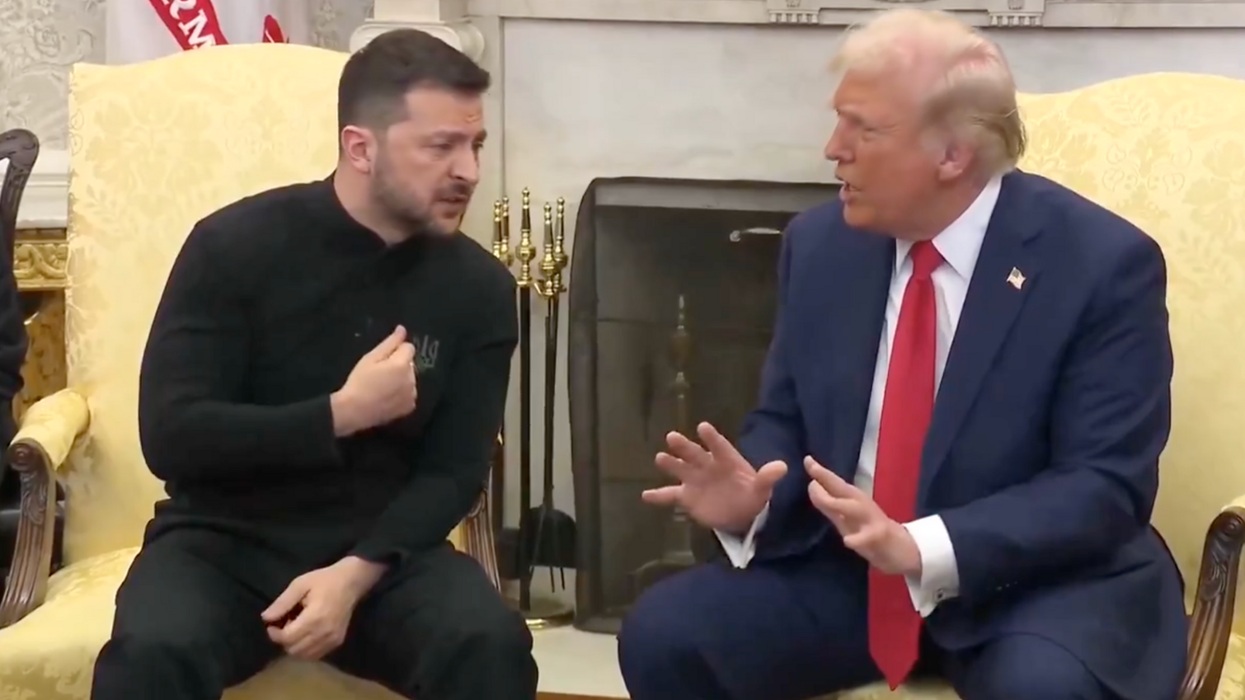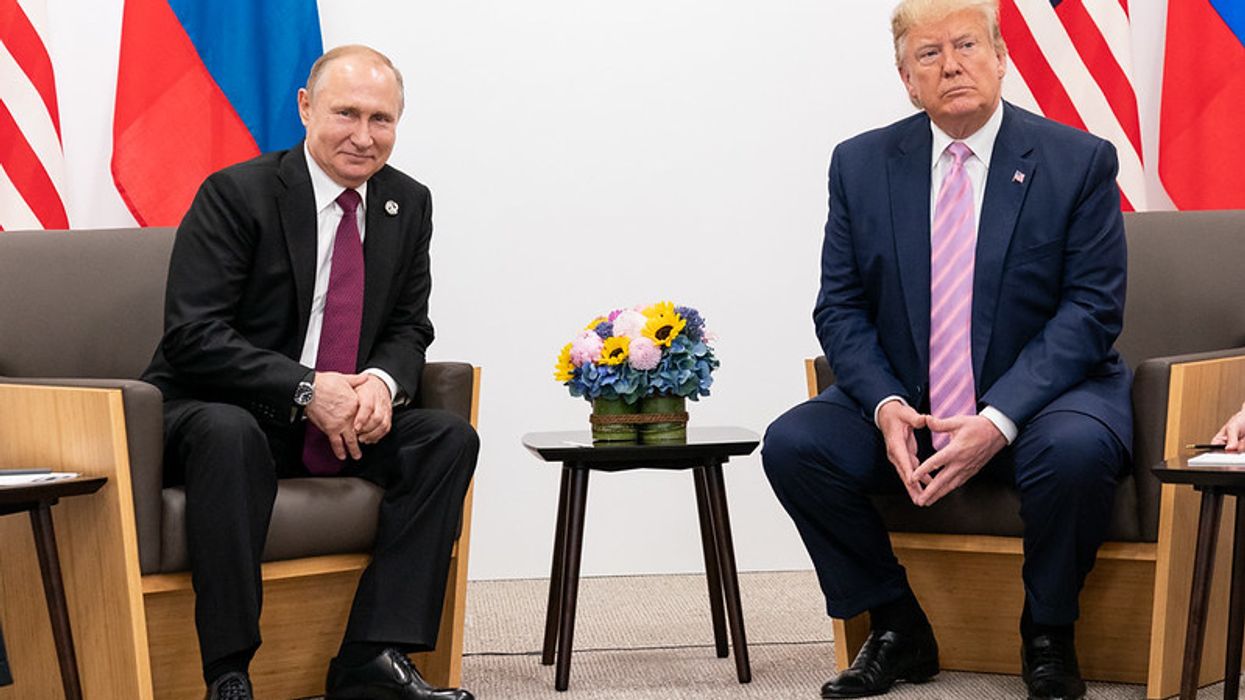President Donald Trump’s actions over the past few weeks have drawn cheers from Russian President Vladimir Putin’s government — and with good reason.
Trump falsely blamed Ukraine for the war that began with Russia’s 2022 invasion and described Ukrainian president Volodymyr Zelensky as a “dictator,” then threw him out of the White House following a public confrontation. His administration over the same period began working with Russia on terms for a ceasefire with Ukraine, attempted to extort Ukraine for partial U.S. control of its rare mineral rights, voted with Russia against a United Nations resolution condemning its “aggression” in Ukraine, floated U.S. sanctions relief for Russia, and on Monday cut off military aid to Ukraine.
The remnants of the right-wing media still somewhat in step with the values of Ronald Reagan have spoken out against Trump’s Putinist turn. But its more popular and influential members are lining up behind the president and praising his actions.
The right-wing commentariat’s decade-long shift from near-universal antagonism to Russia to eager amplification of Kremlin propaganda has helped create the environment for Trump’s recent moves selling out Ukraine in favor of an effective alliance with Putin.
As late as 2012, the GOP and its propagandists were still uniformly anti-Russia. When former President Barack Obama told then-Russian President Dmitry Medvedev that he would have “more flexibility” to negotiate on the issue of missile defense after the November election, his words were seized upon by right-wing commentators across the spectrum, from far-right outlets like Breitbart.com and The Gateway Pundit to the staid conservatives of The Wall Street Journal's editorial board to the pseudopopulists of Fox News, where hosts repeated the attack for years.
But following Obama’s reelection, a faction of the right changed course. Initially they were a fringe group seeking to rehabilitate Putin — a dictator who assassinated political opponents and defiant journalists — as a contrast with the purportedly elite Democratic president and what they deemed his excessively pro-LGBTQ policies. But the faction grew over time, drawing support from pundits like Sean Hannity, who sought counternarratives to excuse Trump’s Russia ties and attack Joe Biden’s Ukraine ones, and Tucker Carlson, who seemed to simply favor Russia’s success in its invasion of its neighbor.
The shift toward Russia became so prominent that in recent years, GOP lawmakers have sounded the alarm about pro-Kremlin propaganda infesting their party’s communications apparatus. And now, we are seeing the devastating consequences.
2013-2014: The right launches love affair with “macho man” Putin, calls him “one of us”
The right’s Putinist turn began as a revolt against a potential future of equal rights and dignity for LGBTQ people and escalated as the movement came to champion the brutish Russian dictator as an anti-Obama.
Putin signed sweeping laws during the summer of 2013 which banned the dissemination of “gay propaganda” and prohibited same-sex couples in Russia and foreigners from nations with marriage equality from adopting Russian children. This triggered widespread condemnation and even calls to boycott the impending Winter Olympic Games in Sochi, Russia.
When Obama added his voice, saying in an August appearance that he had “no patience” for countries that impose laws “violating the basic morality that I think should transcend every country,” a faction of right-wing media responded by siding with Putin.
“Our moral and cultural elites have put Putin on notice: Get in step with us on homosexual rights — or we may just boycott your Sochi games,” wrote the paleoconservative Pat Buchanan. “What this reveals is the distance America has traveled, morally and culturally, in a few short years, and our amnesia about who we Americans once were, and what it is we once believed.”
Buchanan added that Putin was trying to restore the “moral compass” of the Orthodox Church. After quoting a Putin remark praising Christianity’s influence on Russia, he wrote: “Anyone ever heard anything like that from the Post, the Times or Barack Hussein Obama?”
(Putin’s opposition to marriage equality made him “one of us” in “the culture war for mankind’s future,” Buchanan suggested later that year.)
Right-wing commentators over the following years began praising Putin as the polar opposite of the caricature they had created of Obama as an effete, indecisive intellectual. In disputes between Putin and Obama — between Russia and the United States — they started hewing to the Kremlin line.
Amid U.S.-Russian altercations over the Syrian civil war, Matt Drudge deemed Putin “the leader of the free world,” while Tucker Carlson argued that he was “riding to President Obama's rescue.”
As Russia invaded Ukraine the following month, right-wing pundits like Fox’s Bill O’Reilly dissected photos of shirtless “macho man” Putin on a horse and a helmeted Obama on a bicycle. While Russian troops were occupying the Crimean Peninsula, Rudy Giuliani was telling Fox’s audience that Putin is “what you call a leader” because “he makes a decision and he executes it quickly,” while Obama has “got to think about it” before taking action.
At times, the right’s Kremlinist corps would make explicit its desire to have the Russian running the U.S. instead of Obama.
“Can we get like Netanyahu or like Putin in for 48 hours, you know, head of the United States?” former Fox host Kimberley Guilfoyle commented in August 2014. “I just want somebody to get in here and get it done right, so that Americans don't have to worry and wake up in the morning fearful of a group that's murderous and horrific like ISIS.”
2015-2016: Trump’s Russia ties trigger right-wing excuses
While the right-wing media’s pro-Putin faction was not yet dominant, it included one particularly influential figure: Donald Trump, the reality TV star and real estate mogul who had become the GOP front-runner for the 2016 presidential nomination.
Trump touted Putin on the campaign trail as a “powerful leader” who “represented his country” better than Obama did the U.S. That praise, along with Trump’s known past (and secret contemporaneous) business interests in Russia; his hiring of campaign advisers notorious for their ties to the country; his waffling on NATO’s security guarantees; his open call for the Kremlin to intercede on his behalf; and the clear (and ultimately successful) effort by Russia's government to help him win the 2016 election triggered widespread concern about his ties to the country as he ascended to the Republican nomination and then the presidency.
Trump’s pro-Russia stance was unacceptable for some in the right-wing media — but not the stars of Fox, who made excuses for his actions.
In July 2016, for example, Trump called on Russian intelligence services to follow up their successful hack of the Democratic National Committee by finding Hillary Clinton’s emails.
“Russia, if you’re listening, I hope you’re able to find the 30,000 emails that are missing," Trump said during a press conference. “You will probably be rewarded mightily.”
National security experts were horrified. But on Fox, the comment was played off as either a joke, a misunderstanding, or a media lie.
“The media has got the whole thing wrong,” Hannity claimed. “They’re purposefully distorting this whole thing, which is what they do.”
“I think what he was saying was they already stole them. They have them. Can you please return them to us,” offered Carlson.
Both Greg Gutfeld and Bret Baier told viewers that Trump had been making a joke.
However, the Kremlin seemed to take Trump both seriously and literally.
“Russian officials began to target email addresses associated with Hillary Clinton’s personal and campaign offices ‘on or around’ the same day Donald Trump called on Russia to find emails that were missing from her personal server,” PBS reported of an indictment brought by special counsel Robert Mueller two years later.
As the extent of Russia’s pro-Trump campaign came into focus, the most devoted Trumpists waved it away.
Carlson posited that claims that Russia had been behind the leaked Democratic emails published by WikiLeaks were “a lie” and repeatedly argued that the U.S. intelligence community was pushing an “unsubstantiated claim” that cyberattacks on American political institutions were “a Russian propaganda effort.”
Hannity put forward a similar thesis about the allegation of a Russian hack-and-leak effort to benefit Trump. “I'm just assuming this is another liberal media fake news story that they're all falling for, and it's politically motivated,” he claimed.
It was not.
2017-2020: Trump defenses lead to a tightening embrace of Russian propaganda
The Trumpist right’s fervent need to defend him at all cost led to its inexorable adoption of pro-Russian narratives over the course of his presidency. During Trump’s four years in office, three main threads braided together into a rope yoking pro-Trump media figures to Putin.
First, Trump continued to habitually praise Putin and take inexplicably pro-Russian actions over the course of his presidency. In response, pro-Trump media figures defended him by explaining away or ignoring what other press outlets and even members of Trump’s own party considered abhorrent.
Trumpist commentators became practiced in responding to the president’s public statements about Russia, arguing that in contrast to his rhetoric, his “actions” against Russia had been “tough.” When Trump shocked the international community by standing next to Putin at a 2018 press conference in Helsinki and validating the Russian dictator’s false claim that he had not interfered in the 2016 presidential election, Trump’s media allies touted his “very strong” performance and criticized the “mass hysteria” to the contrary. And damning reports about Trump sharing classified information with the Russian ambassador at the White House and meeting with Putin without a note taker or translator were downplayed or avoided altogether.
Second, Mueller’s investigation created a steady stream of damaging stories for Trump as the special counsel successfully indicted and prosecuted some of the president’s closest aides, revealing both the breadth of the Kremlin’s effort to bolster Trump’s campaign and the eagerness of Trump’s allies to participate. In response, Trump’s media supporters, led by Fox’s Hannity, developed a sprawling counternarrative in which Mueller’s Russia probe was the result of a “soft coup” by a shadowy cabal of journalists, Democrats, and “deep state” operatives.
Night after night, Hannity and his anti-Mueller crew put forward a series of bogus premises: “The media has been corrupt and lying to you”; “so-called Trump Russia collusion” is a “tinfoil hat conspiracy theory,” while Democrats had committed the “real collusion” with Russia; Trump was the victim of “the biggest abuse of power corruption case in American history”; and a second special counsel was needed to “expose” all of the above and ensure that the perpetrators “go to jail.”
With Trump amplifying such claims and rewarding Republicans who promoted them, these talking points became the heart of the GOP’s Mueller rebuttal. The counternarrative even led to the appointment of a special counsel for an “investigation of the investigators,” albeit one who turned up remarkably little of note.
Third, Russia’s campaign to sway U.S. elections on Trump’s behalf continued as the president sought reelection in 2020. Right-wing media figures like Hannity and John Solomon responded by participating: They teamed up with Trump lawyer Rudy Giuliani, the minions of a pro-Russian Ukrainian oligarch, and a sanctioned Ukrainian lawmaker described by the U.S. government as “an active Russian agent” to concoct and disseminate purported evidence that former-Vice President Joe Biden acted corruptly by pushing Ukraine to fire its top prosecutor, who was supposedly investigating Biden’s son’s business interests.
This disinformation campaign was flagrantly false — U.S. policy called for firing the prosecutor, who was viewed as unwilling to prosecute corruption by U.S. diplomats, foreign governments, international bodies, and Ukrainian anti-corruption groups.
But the right-wing narrative caught Trump’s eye. He subsequently tried to condition vital military aid to Ukraine and a state visit by Zelensky on the Ukrainian president announcing an investigation into the Bidens. The revelation of Trump’s conduct ultimately triggered his first impeachment — during which his media allies settled on the conclusion that the president had done nothing impeachable.
As Trump’s Fox propagandists scrambled to defend his conduct, one host broke new ground by suggesting that the U.S. shouldn’t have been supporting Ukraine in the first place.
“Why do I care? Why do I care what's going on in the conflict between Ukraine and Russia?” Carlson asked on his prime-time show. “Like, why do I care? And why shouldn't I root for Russia? Which I am.”
Carlson quickly claimed he had been joking — but the mask had slipped.
2021-2024: MAGA pundits swallow Kremlin line on Ukraine, Biden
On March 3, 2022, just days after Russia launched its invasion of Ukraine, a Russian government agency issued new instructions to state-sponsored propaganda outlets: Promote Tucker Carlson.
“It is essential to use as much as possible fragments of broadcasts of the popular Fox News host Tucker Carlson, who sharply criticizes the actions of the United States [and] NATO, their negative role in unleashing the conflict in Ukraine, [and] the defiantly provocative behavior from the leadership of the Western countries and NATO towards the Russian Federation and towards President Putin, personally,” the memo, which was leaked to Mother Jones, stated.
The Kremlin’s assessment of Carlson’s broadcast was accurate. The Fox star, in the days before and following the Russian incursion, had passionately defended Putin, criticized Zelensky as Biden’s “puppet” and his country as a “growing dictatorship,” denied that a war was imminent and then blamed the U.S. for its start, and mocked the bipartisan supporters of U.S. aid to Ukraine. And over the following months, a Carlson-Kremlin feedback loop developed in which Carlson picked up disinformation campaigns originating with Russian state media, then Russian outlets promoted his reports.
Carlson was the loudest and most influential MAGA media figure to adopt pro-Russian talking points about the country’s brutal bombing and occupation of portions of Ukraine — but he and his guests were far from alone.
Commentary that toed the Putin line became increasingly commonplace on the right among Carlson’s Fox colleagues as well as from online fever swamps like The Gateway Pundit and far-right influencers like Jack Posobiec. Within months, the right-wing propaganda machine was in full-scale revolt over the U.S. sending aid to support Ukraine’s fight against the Russian invasion.
The MAGA movement’s information ecosystem became increasingly honeycombed with pro-Putin propaganda over the course of the war.
Hannity, his House Republican allies, and his Fox colleagues spent 2023 attempting to manufacture an impeachment case against Biden which largely rehashed the disinformation debunked four years earlier about the fired Ukrainian prosecutor. The story did feature one new wrinkle — a report from an FBI informant that a Ukrainian oligarch had paid Biden a $5 million bribe to get the prosecutor removed.
Hannity promoted that account in dozens of segments, arguing that the FBI informant’s “bombshell” was “smoking-gun evidence” of “the very definition of a high crime,” and “might end up being the biggest story of the year.” But the tale disintegrated in February 2024 when federal prosecutors arrested the informant — who reportedly had deep ties to Russian intelligence — and charged him with fabricating his allegations (he later pleaded guilty). The GOP’s impeachment push dissolved soon after.
Meanwhile, Carlson was not just excusing Putin’s invasion, but doing an interview with the Russian dictator that was heavily touted by Kremlin propagandists and producing glowing videos that extolled the Russian system.
The situation became so bleak that in April 2024, Rep. Michael McCaul (R-TX) — the former GOP chairman of the House Foreign Affairs Committee — told a reporter that because of right-wing media, Russian propaganda had “infected a good chunk of my party’s base.”
McCaul was not exaggerating — later that year, federal prosecutors alleged several prominent right-wing influencers had unwittingly received millions of dollars that originated from a Russian government operation aimed at promoting Donald Trump.
They didn’t push Russian talking points for the money — the Kremlin gave them the money because, like so many of their MAGA colleagues, they were already pushing Russian talking points.
Reprinted with permission from Media Matters.












